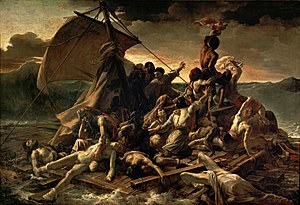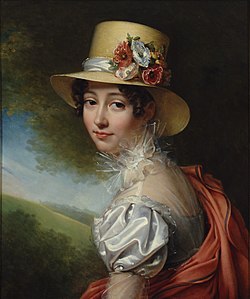This is an old revision of this page, as edited by Lord Cornwallis (talk | contribs) at 19:38, 19 December 2024 (←Created page with '{{Short description|1819 art exhibition in Paris}} thumb|300px|''] The '''Salon of 1819''' was an art exhibition held at the Louvre in Paris between 25 August and 30 September 1819. It was the largest Salon (Paris) to be staged since the fall of Napoleon.<ref>Boime p.145</ref> It took pl...'). The present address (URL) is a permanent link to this revision, which may differ significantly from the current revision.
Revision as of 19:38, 19 December 2024 by Lord Cornwallis (talk | contribs) (←Created page with '{{Short description|1819 art exhibition in Paris}} thumb|300px|''] The '''Salon of 1819''' was an art exhibition held at the Louvre in Paris between 25 August and 30 September 1819. It was the largest Salon (Paris) to be staged since the fall of Napoleon.<ref>Boime p.145</ref> It took pl...')(diff) ← Previous revision | Latest revision (diff) | Newer revision → (diff) 1819 art exhibition in Paris
The Salon of 1819 was an art exhibition held at the Louvre in Paris between 25 August and 30 September 1819. It was the largest Salon to be staged since the fall of Napoleon. It took place during the Restoration era with Louis XVIII on the throne. It was the first to be held since the withdrawal of Allied Occupation forces from the country at the end of the previous year. The two officials behind the exhibition the Count Forbin and Vicomte de Senonnes set out to make it even more a celebration of the House of Bourbon that the previous Salon of 1817.
Over a hundred paintings were in the then fashionable Troubadour style including Roger Freeing Angelica by Jean-Auguste-Dominique Ingres. Alexander the Great Visiting Apelles by Marie Nicolas Ponce-Camus was rejected from submission as the jury believed it alluded to a visit Napoleon had made to the studio of Jacques-Louis David during the Hundred Days.
Amongst those who exhibited was the rising star Ary Scheffer. The standout work was The Raft of the Medusa by Théodore Géricault depicting the shipwreck of the frigate Medusa.
Gallery
-
 Portrait of Zoé Jacqueline Duvidal de Montferrier by Julie Hugo
Portrait of Zoé Jacqueline Duvidal de Montferrier by Julie Hugo
-
Domenichino by Julie Charpentier
-
 Massacre of the Mamelukes by Horace Vernet
Massacre of the Mamelukes by Horace Vernet
-
 Portrait of the Duchess of Angouleme by Louise Bouteiller
Portrait of the Duchess of Angouleme by Louise Bouteiller
References
- Boime p.145
- Boim p.145
- Boime p.145
- Boime p.145
- Spitzer p.31
- Miles p.178
Bibliography
- Boime, Albert. Art in an Age of Counterrevolution, 1815-1848. University of Chicago Press, 2004.
- Harkett, Daniel & Hornstein, Katie (ed.) Horace Vernet and the Thresholds of Nineteenth-Century Visual Culture. Dartmouth College Press, 2017.
- Miles, Jonathan. Medusa: The Shipwreck, the Scandal, the Masterpiece. Random House, 2008.
- Noon, Patrick & Bann, Stephen. Constable to Delacroix: British Art and the French Romantics. Tate, 2003.
- Spitzer, Alan Barrie. The French Generation of 1820. Princeton University Press, 2014.